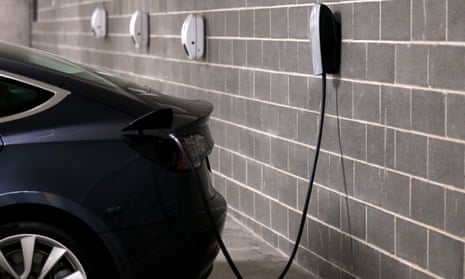The joint venture partner in Australia’s largest lithium mine is reducing production of the important battery mineral, and halting one of its nickel operations, as plunging prices threaten to overwhelm a sector crucial to the electrification of the automotive industry.
Perth-based IGO has confirmed production cuts to its Greenbushes operations, located near the tiny West Australian timber and mining town the mine is named after, because of subdued demand for battery-grade lithium chemicals.
The miner also announced on Wednesday it would halt production at its Cosmos nickel project, also in WA, in the face of deteriorating prices.
“The rapid deterioration of the nickel price over the last six months has meant it would not be prudent for us to continue with the project at this time,” IGO’s chief executive, Ivan Vella, told analysts on Wednesday.
“Times like this are very tough for our people. And we’re working hard to redeploy as many of our people as possible.”
Vella said while the long-term outlook for lithium was strong, the miner had to be prudent given current prices.
“The market is still very uncertain at this point,” he said.
The decision to reduce production of battery minerals by a well-established and comparatively low-cost miner shows how the crash in battery mineral commodities is washing through the resources sector, and denting national aspirations to profit from the global transition to electric vehicles.
Since late 2022, lithium prices have fallen more than 80%, while nickel is down by 40%, according to benchmark prices. Cobalt, another battery mineral, has lost 40% of its value.
Australia’s mining sector has started discussions with government representatives about potential tax credits, royalty relief and emergency funding plans, designed to keep some of the smaller miners afloat.
The price falls have been blamed on an oversupply of battery minerals, caused by a rush by miners to profit from the rise of EVs. While EV demand continues to grow, sales appetite has lagged projections, creating a supply and demand imbalance.
The timeline for price parity between mass market EVs and petrol equivalents was also pushed back after Covid 19-related disruptions struck the automotive sector, delaying the planned overhaul of factories to boost EV numbers.
The delay in price parity has subdued sales, with inflation-hit consumers looking for cheaper vehicles.
Mineral outlook
The outlook for nickel is clouded by the rise of rival mining jurisdictions, including Indonesia, that are extracting the battery mineral at lower costs, threatening to dampen prices over the longer term.
In response, IGO’s Cosmos mine will join First Quantum Mineral’s Ravensthorpe nickel and cobalt mine, also in WA, and Andrew Forrest’s Wyloo Metals in shutting nickel operations.
But Australia retains its standing as the world’s dominant lithium producer, and analysts expect prices to eventually recover. Unlike nickel, there is no imminent threat of new jurisdictions displacing Australian production.
This week, IGO downgraded its guidance from Greenbushes after disclosing that sales will be about 20% lower than production for the current six-month period.
Greenbushes, one of the most lucrative lithium mines in the world, is 51%-owned by a joint venture of IGO and Chinese company Tianqi. The remaining stake is controlled by New York-listed Albemarle, a large chemicals manufacturer.
Seth Goldstein, a US Morningstar analyst, said production cuts and delays to new lithium supplies out of Australia could have a large effect on global supplies, especially as demand recovers.
“While I don’t think cuts are needed for prices to rise, they will likely lead to a faster recovery,” he told Guardian Australia.
Goldstein said he expected the lithium market to “swing to undersupply” as EV sales rose.
“I think lithium prices will rise in 2024, especially in the second half of the year,” he said.
